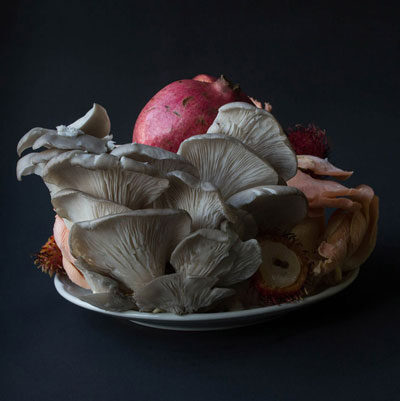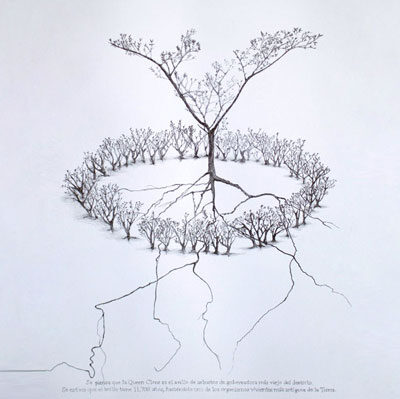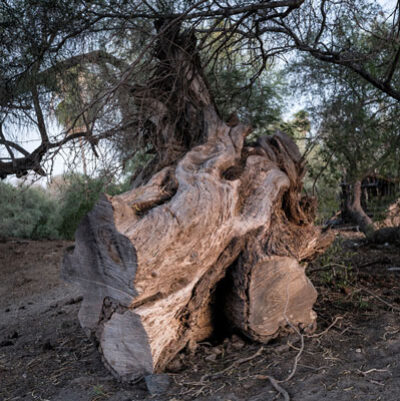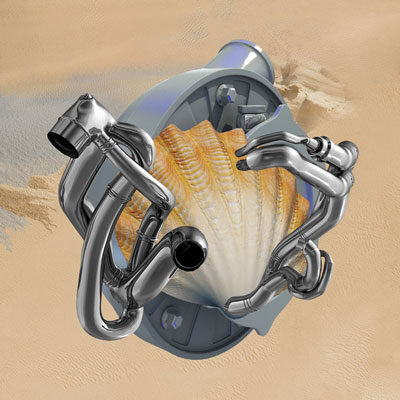Suspending Control Curated Ingrid Hernández
Suspending Control
by Ingrid Hernández
This exhibition approaches climate emergency not through spectacle or collapse, but by attuning to its quieter signals—those subtle shifts that unfold in the margins of daily life. The works gathered here propose ways of sensing, narrating, and embodying ecological crisis through practices anchored in specific territories, intimate gestures, and multi-species entanglements. Rather than offering solutions or grand narratives, they engage with what resists being controlled: water, dust, memory, the body, the more-than-human.
There’s a forest living in the poop, by Eréndira Gómez, shifts the scientific, objectivist gaze toward a practice of interspecies listening and collaboration that allows for the imagining of other ways of relating to the non-human. Through performative actions—vocalizations, speculative dances, symbolic rituals—the artist engages in situated encounters with howler monkeys, activating the body as a medium of translation and relational listening. These gestures point toward affective and ethical ways of coexisting, decentering the human to imagine shared futures rooted in sensorial kinship.
In Las últimas del desierto, Jessica Sevilla offers a sharp visual satire of corporate environmental discourse. Drawing from the symbolic weight of the triangle—at once diagram, promise, and icon of control—the project revisits the Colorado River Delta as a contested site where “restoration” conceals extractive geopolitics. By mimicking the visual language of power and then unraveling it, the work exposes how technocratic aesthetics obscure asymmetries and reproduce colonial desires.
For Elizabeth Moreno Damm, the prolonged drought in Baja California Sur is the starting point for a photographic project that documents a disappearing rural way of life. Charcoal trees, abandoned ranches, and resilient inhabitants form a fragile archive of what persists and what fades. Through human and vegetal portraits, this work captures the erosion of rural knowledge, cycles of subsistence, and intimate ecologies affected by climatic shifts that often remain unnamed.
In Desaprender del animal, Andrea Carrillo Iglesias, maps a series of ecological exotisms that have historically shaped Baja California’s desert imaginary. Focusing on off-road races—massive spectacles of domination over terrain—the project contrasts the technological weight of Trophy Trucks with the almost imperceptible agency of desert dust. In the fine sand that clouds the vision and unsettles the ground, control is momentarily suspended. The work gestures toward the fragility of progress narratives and the latent power of the seemingly negligible.
Finally, Archivo Familiar del Río Colorado weaves historical documents, archival interventions, and performative gestures to reflect on the diverted flows of the river and their metabolic consequences. Developed in Mexicali—one of the delta’s most altered urban landscapes—the project constructs an affective geography of water, exploring both its rhythmic continuities and disrupted cycles. Here, the river is not only a wounded body but also a living memory resonating through more-than-human kinships.
Together, these five projects propose an ethics of attention—one that listens to shifts in scale, silence, and sediment. In suspending control, they invite us to imagine other forms of knowing, relating, and inhabiting a world in transformation. The climate crisis is not only a matter of catastrophe, but of perception: What is at stake is not only the future of the climate, but the very possibility of building an ethics of interdependence rooted in everyday life.
Ingrid Hernández is a visual artist born in Tijuana, B.C., and a member of Mexico’s National System of Art Creators. Her practice moves across the territories of visual production, writing, and cultural work. Through projects that combine image-making, public actions, and text-based inquiry, her work examines the asymmetries of border geopolitics, processes of self-construction, and the circulation of discarded materials across territories.
As a curator, she has developed exhibitions such as Revisión. Fotógrafos de Nuevo León 2024 (CONARTE); Territorio(s), part of Fotoseptiembre México at the Centro de la Imagen (2022); and Geografías Domésticas at The Front Gallery in San Ysidro (2021). Across these curatorial projects, she weaves lines of inquiry that connect artistic practices with affective experience, territorial engagement, and long-term research.
Her writing includes texts such as Territorio(s) (Centro de la Imagen, 2022); Photographic Formation on the Periphery of Mexico, published in the Fotoseptiembre México catalogue (2022); and The Biennial: Toward a Space for Pluralities, in the catalogue of the XIX Biennial of Photography (2021), among others.
She is co-founder and director of Relaciones Inesperadas, a platform for the development of contemporary artistic practices within a pedagogical framework, established in Tijuana.
There’s a forest living in the poop
Conversations with Howler Monkeys is an artistic research project grounded in performative practices that explores interspecies communication from a sensitive, poetic, and embodied perspective. These actions emerge from a vital and epistemic shift experienced by a scientist who, after years of studying animal behavior through a positivist and objectifying lens, transitions toward a multispecies collaboration paradigm. In this new framework, howler monkeys (Alouatta palliata) are no longer merely research subjects, but relational agents, knowledge holders, and co-participants in the situated production of knowledge.
This inquiry inhabits the intersections of art, science, technology, and spirituality. It proposes affective, symbolic, and ethical encounters with more-than-human beings as a way to decenter the human, generate shared meaning, and open pathways for imagining more just, collaborative, and sensitive futures—futures attuned to the intricate web of life forms that dwell within these territories.
The research consists of a series of performative actions developed in the field: from speculative vocalizations and dances in clearings of disturbed forest, to a symbolic wedding with the jungle itself—a gesture of renunciation of romantic love and an opening toward broader affective bonds. In another action, a primate figure from the future invites the audience to dance cumbia as a way to think through the body about alternative modes of interspecies relating. These practices activate the body as a medium for listening and translation, expanding the field of the knowable toward the sensorial, the symbolic, and the collective.
This artistic research project was supported by the Patronato de Arte Contemporáneo A.C. and the Dirección de Comunicación de la Ciencia at Universidad Veracruzana.
—
Home Recording of the Wedding with Forest
2023
Action performed at El Jardín de las Esculturas, Xalapa, Veracruz.
Audiovisual documentation
5:17 minutes
Eréndira Gómez-Espinosa (Veracruz, 1985) is a dancing animal-plant. A Doctor in Neuroethology and visual artist, her work unfolds at the intersection of art, science, technology, and ancestral healing knowledge, exploring trans-species languages in the forests of southern Veracruz. Inspired by the SF writings of Donna Haraway and Vinciane Despret’s notion of “asking-with,” her artistic research practice is rooted in the creation of multispecies assemblages as forms of care and cohabitation. In dialogue with howler monkeys, she has begun sowing a living and speculative forest through situated performative practices. She has been a grantee of FONCA and the Photographic Production Seminar at the Centro de la Imagen. She received the acquisition prize at the 5th Veracruz Art Biennial and was selected for the Dior Prize for Photography and Visual Arts for Young Talent (LUMA Arles). She is currently developing a new chapter of Dialogues with Howler Monkeys, a project initially supported by PAC A.C. and the Universidad Veracruzana.
The Last of the Desert
The Last of the Desert is an essay and a satirical fiction about the language of power. The project unfolds through a video, a sculpture, and a series of images that combine drawings, photographs, appropriated archival materials, and news fragments.
It takes up the figure of the Golden Triangle, present in the corporate social responsibility discourse used by Arca Continental and Coca-Cola, and turns it into a central metaphor. In this project, to rehearse the language of power means to reclaim it in order to imitate its forms and outputs —such as newspaper front pages, inaugural speeches, diagrams that promise “solutions for the population,” or those that seek to explain the world, like the ones drawn by Robert Fludd between the 16th and 17th centuries.
These forms are appropriated, parodied, in some cases they inspire representational strategies, and are ultimately blurred through the figure of the triangle —a symbol also present in religious, esoteric, and state iconographies since antiquity, such as the pyramid or the Holy Trinity.
Linked to a long-term project that began in 2020 —a historical, geographical, and cultural investigation into the landscape of the Colorado River Delta— this essay also operates as a critique of the magnanimous, salvationist initiatives of environmental restoration. Behind these efforts lie extractive, expansive, and accumulative forces. The delta (Δ) is a triangle. And this triangle, located on the Mexico–United States border, is not equal on all sides. It could be drawn as equilateral, but it clearly has a base and a tip. And the tip insists on remaining the tip.
At the same time, the triangle replicates itself in the material world in organic and ungovernable ways —for instance, in the roots of the oldest plants on the planet, in this desert, and in this Δ.
This piece was co-financed by Planta Libre gallery, Mexicali, thanks to the invitation of Minoru Kiyota to participate in the Proyectos program at Material Art Fair Vol. 11.
Jessica Sevilla is an artist, researcher, curator and cultural organizer. Her practice is a long-term project anchored in the space she inhabits and sustained by continuous fieldwork that weaves together research, creation, pedagogy, urbanism, and landscape.
She explores territorial, ecological, affective, and power relations along the Mexico–United States border, observing how they become embedded in the material and spiritual dimensions of bodies. She writes, creates visual essays and installations—recently working through fiction and irony. She also organizes platforms for collective thinking and, together with friends and collaborators, explores ways of building archives rooted in place and experience.
She is the curatorial coordinator of the Colorado River Family Archive, an artistic and curatorial research project, and is currently writing a doctoral dissertation on the production of the affective waterscape in the Colorado River Delta, from a cultural studies perspective.
Her visual work has been exhibited at the Baja California Photography Biennial, the Armory Center for the Arts (Pasadena), the Cheech Marin Center (Riverside), the San Agustín Arts Center (Oaxaca), the Steppling Art Gallery (Calexico), naebono art studio (Sapporo) and in multiple public spaces in Mexicali. She has received support from FONCA, the Patronato de Arte Contemporáneo, PECDA BC, CONAHCYT, and the David Rockefeller Center for Latin American Studies. Her short stories and fiction have been published in various magazines and anthologies in Mexico and Argentina.
When the rain doesn’t come, from the series Close to earth
My photographic work arises from a deep concern about the environmental and social changes that are transforming the rural landscape of Baja California Sur. In this region, the knowledge of those who live off the land reveals that, for more than a decade, seasonal rains have ceased to be regular. Today, in some areas north of La Paz, it has been three years without a single significant rainfall—a drought that alters not only the land but also the life that persists upon it.
For generations, the production of charcoal—from mesquite and other desert
species—has been an economic alternative during times of drought. Thus, the trees that once provided shade and sustenance are turned to ashes after a barbecue or charcoal- grilled hamburger in the city. In the countryside, only the remains of their old trunks endure, silent witnesses to a way of life that is slowly disappearing. Likewise, some ranches, once full of voices and labor, now stand silent and empty, displaced by circumstance.
Through photography, I document both those who remain—deeply rooted in these arid lands—and the remnants of the trees that once stood with them. Their portraits—human and vegetal—engage in a silent dialogue, telling stories of resilience, loss, and transformation. This work is an attempt to shed light on the complex relationship between territory, subsistence, and permanence amid a silent crisis.
Elizabeth Moreno Damm (1983). Her work has focused on the documentary field, primarily in Baja California Sur, where she explores life in the mountains and along the coast, as well as the transformation of the natural environment. She has received recognitions such as First Place in the Daylight/CDS Documentary Photo Awards (2010) in the Work-in-Progress category, the Jury Prize in the competition El México de los Mexicanos II (2014), and the Fujifilm GFX Challenge Grant / Regional Award (2022).
In 2019, she published her first book, Cerca de la tierra, with support from National Fund for Culture and the Arts (FONCA). The book presents nearly a decade of documentary work (2010–2019) on everyday life in the ranches of southern Baja California. This body of work has been recognized with awards and exhibited both individually and collectively in Mexico and internationally, including in Colorado, New York, North Carolina, and Nevada (USA), as well as in Spain, France, Chile, and Japan.
Desaprender del animal
Desaprender del animal is a long-term project, an investigation into the natural landscape of Baja California that reviews a series of exoticisms that have historically defined this peninsula, shaping not only our perceptions and relationships with this desert but with nature in general. The project is articulated around a journey I made from Tijuana to Santa Rosalía in 2021. During this trip, I traced what I call a geography of natural exoticisms; an in situ investigation into the concrete expressions of the human desire to exploit and dominate nature. This geography of exoticisms includes the illegal commodification of cacti and fossils, the controlled hunting of bighorn sheep, the excessive extraction of minerals, and the ecosystem deterioration caused by off-road racing. Through these exoticisms, the project seeks to reveal the extractive economic processes that have forged the imaginary of this region and how these processes connect with the neocolonial narratives of expansion and tourism, which continue to contribute to the climate crisis.
The selection of works presented focuses particularly on off-road racing and its ecological, economic, symbolic, and cultural implications for the peninsula. Within the broader world of off-road racing we find the famous Baja 1000. This race is a 1,000-mile (1,609-kilometer) course that involves crossing the desert from end to end, burning around 900 gallons of gasoline. The star vehicles are the so-called Trophy Trucks, large machines with military technology and powerful engines that allow the racers to navigate difficult terrain. Throughout the desert, racers face the famous silt beds, beds of ultra-fine sand. Driving on them is like driving on water; the challenge is to cross them as quickly as possible without sinking. Doing so not only can one lose control, but the sand rises, creating a kind of cloud that envelops the vehicle. The sand, being so fine, with minimal density and weight, rises upon contact with the intersection, forming this enormous cloud that hangs inside and outside the vehicle, completely obstructing visibility for several minutes. The image of these heavy machines, with 950 horsepower and a-meter tall tires, is weakened by the lightness of the sand. This project turns our attention toward the natural agency of the minuscule and contrasts it with the physical and technological weight of the car and what it symbolizes. Through invisible natural dynamics, the project seeks to destabilize the notion of progress and domination of nature.
Video essay “Desaprender del Animal”, filmed in Baja California, 2021.
Andrea Carrillo Iglesias (1986) is a visual artist and graphic designer from Tijuana. Her work combines research and artistic production, exploring the relationship between image, power, and knowledge, as well as their effects on the ways in which our reality is socially and aesthetically produced. Her work fluctuates between moving images, immersive installations, and performance. Through these mediums, she develops alternative narratives that oscillate between fact and fiction, highlighting the ambivalence of production, the gray nature of power, and the possibilities of the imagined.
Carrillo studied Visual Arts at Sandberg Institute, Rietveld Academy, and holds a master’s degree in Art, Design, and Public Domain from Harvard University. He has exhibited in various countries, among some of the institutions are: Museo Jumex, Danza UNAM, Centro de la Imagen, Espacio Odeón, Human Resources and Tenerife Espacio de las Artes. In 2023, he opened Mutualismo, an independent space committed to creating connections and fostering the collective production of art and design in Tijuana. He has been a member of the Coopia cooperative since 2020.
A place that loves Water and other specters
The Colorado River Family Archive presents a selection of documents that offer a brief —and necessarily partial— narrative of the ruptures and transformations in the affective and cyclical flow of water as it moves through the region we inhabit.
The Colorado River Delta forms a valley bounded by mountain ranges to the north and west; by the dune system of the great Altar Desert to the southeast; and by the Gulf of California to the south, where the river flowed for thousands of years until the mid-twentieth century.
In recent decades, ecosystemic flows —alongside the human and more-than-human bodies that compose them— have been forced to adapt in order to persist. The extraction of over ninety percent of the waters that once annually flooded the valley —a result of urbanization and capitalist accumulation in the North American West— has led to deep ruptures and monumental transformations in the metabolic processes that sustain life.
These eight images explore both the rhythmic and cyclical continuities of water in the region and the fractures and mutations in its living flows. We encounter historical records that narrate experiences of contact, play, desire, and attachment to water and the landscapes it shapes, alongside representations from premodern science and governmental campaigns designed to impose and reproduce their own sensible regimes.
Some of the materials included in this narrative were sourced from public archives; others have been produced in recent years through workshops and activities organized by the Colorado River Family Archive in Mexicali, Baja California —a city born from the diversion and domestication of the river’s flow, and now the most populous in the delta region.
We weave this story by interlacing historical records with our own notes, interventions on images, and a performance, along with recordings and atmospheres created by Pastizal Zamudio, an artist working on both sides of the delta’s border. Their performative gestures often allude to the search for attunement with more-than-human beings and flows. Here, their gaze accompanies us in reflecting on how we resonate with rhythms —both larger and smaller— than those our bodies are able to grasp.
archivofamiliardelriocolorado.com
IG
The Colorado River Family Archive (AFRC) is an artistic and curatorial research project aimed at building a living archive about affective relationships with water in the Colorado River Delta region.
Over the past four years, we have explored the multiple ways water connects with the Delta territory, developing public programs that include guided tours and walks through remnants of water bodies and hydrological phenomena in the region; art exhibitions; small publications; art workshops and community archives; public talks; readings; performance events; and other gatherings.
The core team that conceives and organizes these activities also collaborates with local and regional projects, artists, researchers, and partners working on environmental and territorial issues. Among them are Enero y Abril, Leslie García, María Torres, Farrah Karapetian, the Community Driven Archives Initiative at Arizona State University (ASU) Library, ASU’s STS program, the Institute of Cultural Research–Museum at the Autonomous University of Baja California, and INSITE: Artistic Practices in the Public Sphere.
This reading of the archive was carried out by Jessica Sevilla and Mayté Miranda. We thank Ingrid Hernández for inviting us to think through this collaboration with MUMA: Museum of Women Artists.

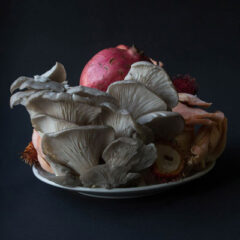
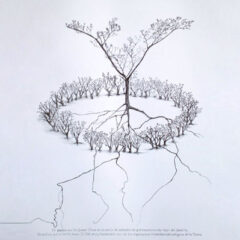
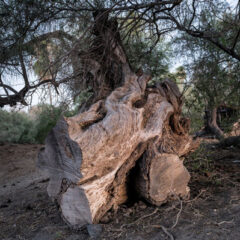
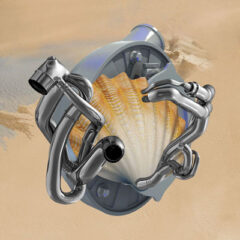
![Un lugar que ama el agua y otros espectros / Archivo del Río Colorado [A mare expelling the placenta minutes after giving birth to a mule during august, one of the hottest months of the year] A place that loves Water and other spectersColorado River Family Archive](https://museodemujeres.com/wp-content/uploads/2025/10/archivo_rio_colorado_thumb-240x240.jpg)
